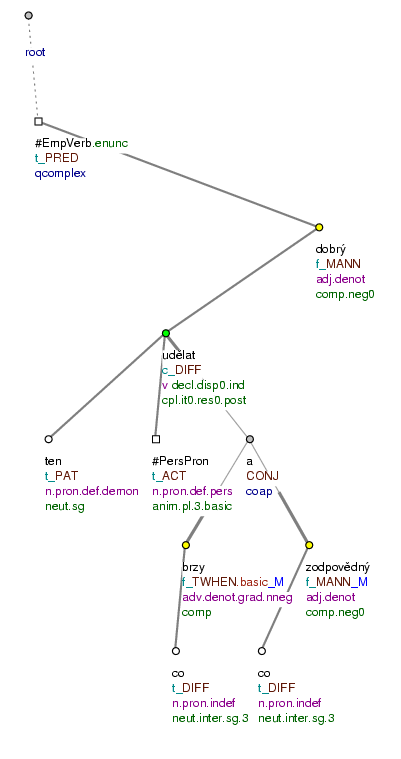The combination of the expressions čím and tím is interpreted as carrying the meaning of difference. For example:
-
Čím je víno starší, tím je lepší. (=The older the wine, the better it is)
The meaning of the construction can be paraphrased like this: the quality of the wine grows with its age. Cf. Fig. 8.95.
Annotation rules.The expression tím in the governing clause is taken to be a supporting expression (see also Section 5.3, "Supporting expressions"). The effective root of the dependent clause introduced by the expression čím has the DIFF functor and is dependent on the node for the adjective in comparative in the governing clause. The node representing čím has also the DIFF functor and depends on the adjective in comparative in the dependent clause. Cf.:
-
Čím.
DIFFdéle to odkládáme.DIFF, <tím> jsou vyšší náklady. (=The bigger the delay the bigger the costs are)The expression tím in the governing clause is a supporting expression. The effective root node of the dependent clause introduced by čím (here the node representing odkládat) gets the
DIFFfunctor and depends on the node representing the adjective in comparative in the governing clause (here vyšší). The node representing čím has also theDIFFfunctor and depends on the adjective in comparative in the dependent clause (on the node for déle). Cf. Fig. 8.96.
More examples:
Čím.DIFF dříve a čím.DIFF zodpovědněji to udělají.DIFF , <tím> lépe. (=The sooner and more responsibly they do it the better) Fig. 8.97
Vážíme si jich <tím> méně, čím.DIFF více se o nich dovídáme.DIFF (=The more we know about them the less we respect them)
Podle ní by zařízení inkasovala od pojišťoven <tím> méně peněz na lůžko, čím.DIFF déle by na něm pacient ležel.DIFF (=The longer time the patient spends there, the less money the hospital gets..)
Čím.DIFF je.DIFF tetováž hlubší, <tím> je složitější její odstranění a slabší výsledný kosmetický efekt. (=The deeper the tatoo is the more difficult it is to remove it..)
Ellipsis of the governing verb. Also a number of constructions in which the governing verb (either in the governing or dependent clause, or in both of them) is omitted belong to this type.
In the position of the omitted verb a new node with the #EmpVerb t-lemma is inserted (according to the rules in Section 12.1.1, "Ellipsis of the governing verb").
These constructions are to be distinguished from the constructions with the expression čím dál tím (see Section 5.2, "Constructions with the expressions "čím dál tím + comparative""); unlike this set expression, there can be many variants here and the missing verb can be easily inferred from the context. Cf.:
-
Čím víc, tím lépe. (=The more the better)
= Čím (je toho) víc, tím (je) lépe. (=The more there is of it the better it is)
Examples:
Čím {#EmpVerb.DIFF} víc tím {#EmpVerb} líp. (=The more the better) Fig. 8.98
Čím má.DIFF víc, tím {#EmpVerb} lépe. (=The more he has the better)
Čím {#EmpVerb.DIFF} míň tím {#EmpVerb} hůř. (=The less the worse)
Čím {#EmpVerb.DIFF} větší tím {#EmpVerb} hloupější. (=The bigger the more stupid)
Figure 8.95. Constructions with the expressions "čím - tím"

Čím je víno starší, tím je lepší. (=lit. By_what is wine older by_that (it) is better)
Figure 8.96. Constructions with the expressions "čím - tím"

Čím déle to odkládáme, tím jsou vyšší náklady. (=lit. By_what longer (we) it put_off, by_that are higher costs)

